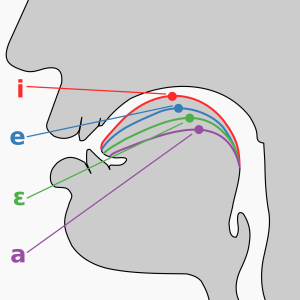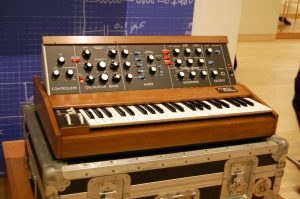3. Performing Forces for Music
Music consists of the intentional organization of sounds by and for human beings. In the broadest classification, these sounds are produced by people in three ways: through the human voice, the instrument with which most of us are born; by using musical instruments; or by using electronic and digital equipment to generate purely electronic sounds.
3.1 The Human Voice as a Performing Force
The human voice is the most intimate of all the music instruments in that it is the one that most of us are innately equipped. We breathe in, and, as we exhale, air rushes over the vocal chords causing them to vibrate. Depending on the length of the vocal chords, they will tend to vibrate more slowly or more quickly, creating pitches of lower or higher frequencies. The muscles in the larynx contract, causing the vocal chords to close, and air pressure forces them open. This closing and opening can happen hundreds of times a second. To reach a higher pitch vocal chords vibrate more rapidly.
Changing the shape of your vocal cavity allows for different timbres and vowel sounds. Changing the position of the mouth and lips allows for further variety in sound and for the production of consonants. Because men tend to have thicker and longer vocal chords, they tend to have lower voices than women, whose vocal chords tend to be shorter and slimmer.
The natural speaking voice exhibits some variation in pitch. One’s voice often rises at the end of a question. When you have a cold and the vocal chords are swollen, you often speak in lower pitches than normal. Singing generally differs from speaking in that it uses a wider range of definite pitches that often occur in a regular meter (discussed later). By range, we mean the number of pitches, expressed as an intervallic distance. A trained opera singer might have a range of three to four octaves, whereas the average person has a range of a little over an octave.

Additionally, as we speak we generally focus on consonants, which articulate the beginnings and ends of syllables and help make our meaning plain. In singing, performers often focus on the vowels, as vowels tend to carry better than consonants. Also, the meaning of the words is sometimes deemed less significant than the melodies themselves.
In Western music, voice ranges are typically split into four categories:
Soprano: highest female voices; sing almost exclusively above middle C (the C approximately in the middle of the range of the piano)
Alto: lowest female voices; sing in a register around and above middle C
Tenor: highest male voices; sing in a register around and below middle C
Bass: lowest male voices; sing in a low register, below middle C
Ex. 1.5: Vocal ranges
Western classical music tends to use all four of these ranges, whereas melodic register and range in jazz, rock, and pop tends to be somewhat more limited. As you listen to jazz, rock, and pop, pay attention to ranges and registers used as well as any trends. Are most female jazz vocalists altos or sopranos? Do most doo‐wop groups sing in higher or lower registers? Different musical voices exhibit different musical timbres as well, as you heard earlier with Ella Fitzgerald and Louis Armstrong.
3.2 Musical Instruments as Performing Forces
Humans have been making music with bone, stone, wood, textiles, pottery, and metals for over 35,000 years. A musical instrument is any mechanism, other than the voice, that produces musical sounds. As we study jazz, rock, and pop we will be listening to two types of musical instruments, purely acoustic instruments and electronic instruments.
Acoustic Instruments
A purely acoustic instrument is an instrument whose sound is created and projected through natural acoustic characteristics of its media. Thus, when one hits wood or bone or stone or metal, one sends vibrations through it which might be amplified by use of a small chamber like a sound box or a gourd. When one plucks a string, one creates sound waves that might be amplified through a piece of wood or box of wood, such as one finds in an acoustic guitar or violin. In general, the larger the instrument, the deeper the pitches it plays—consider for example, the cello versus the violin. Instruments also differ in their ranges, some being able to produce a wide variety of notes while others are much more restricted in the pitches that they can play. (For example, the piano has a range of over seven octaves, while the saxophone normally plays only two and a half).
The timbre of a sound coming from a musical instrument is affected by the materials used and the way in which the sound is produced. Based on these two characteristics, we categorize acoustic instruments into five groups:
Strings: instruments whose sound is produced by setting strings in motion. These strings can be set in motion by plucking the strings with your fingers, or a pick (a piece of plastic). They can also be set in motion by bowing. In bowing, the musician draws a bow (Figure 1.8) across the strings, creating friction and resulting in a sustained note. Most bows consist of horse hair held together on each end by a piece of wood. Examples of string instruments include: violin, viola, violoncello (or cello), bass (also known as double bass or stand-up bass), classical/acoustic guitars, and harp.

Woodwinds: instruments traditionally made of wood whose sound is generated by forcing air through a tube, thus creating a vibrating air column. This can be done in one of several ways. The air can travel directly through an opening in the instrument, as in a flute. The air can pass through an opening between a reed and a wooden or metal mouthpiece as in a saxophone or clarinet, or between two reeds as in a bassoon or oboe. Although many woodwind instruments are in fact made of wood, there are exceptions. Instruments such as the saxophone and the modern flute are made of metal while some clarinets are made of plastic. These instruments are still considered woodwinds because the flute was traditionally made of wood and the saxophone and clarinet still use a wooden reed to produce the tone. Examples of woodwind instruments include: piccolo, flute, clarinet, oboe, English horn, and bassoon.
Brass: instruments traditionally made of brass or another metal (and thus often producing a “bright” or “brassy” tone) whose sound is generated by “buzzing” (vibrating the lips together) into a mouthpiece attached to a coiled tube. This “buzzing” sets the air within the tube vibrating. The pitches are normally amplified by a flared bell at the end of the tube. Examples of brass instruments include: trumpet, cornet, trombone, French horn (or horn), tuba, and euphonium.
Percussion: instruments that are typically hit or struck by the hand, with sticks, or with hammers, or that are shaken or rubbed. Some percussion instruments (such as the vibraphone) play definite pitches, but many play indefinite pitches. The standard drum set used in many jazz and rock ensembles, for example, consists of mostly indefinite-pitch instruments. Examples of percussion instruments include: timpani, bass drum, snare/side drum, drum set, glockenspiel, xylophone, vibraphone, marimba, cymbals, gong, triangle, and tambourine.
Keyboards: instruments that produce sound by pressing, or striking keys on a keyboard. The keys set air moving by the hammering of a string (as in the case of the piano) or by the opening and closing of a pipe through which air is pushed (as in the case of the organ and accordion). All of these instruments have the capacity of playing more than one musical line at the same time. Examples of keyboard instruments include: piano, organ, and accordion.
Listening examples of orchestral instruments and more information about the instruments can be found here. (Note that the harp and keyboard instruments are grouped together, as this is how traditionally they are placed on the orchestral scores.)
Watch this performance of “The Young Person’s guide to the Orchestra” composed by the English composer Benjamin Britten to learn more about the sounds of the instruments and the orchestra.
Ex. 1.6: “The Young Person’s Guide to the Orchestra”
Non-Acoustic Instruments
Electric sounds and instruments: instruments can be electric in several ways. In some cases, an acoustic instrument, such as the guitar, violin, or piano may be played near a microphone that feeds into an amplifier. In other cases, amplifiers are embedded in or placed onto the body of an acoustic instrument. In still other cases, acoustic instruments are altered to facilitate the amplification of their music. Thus, solid body violins, guitars, and basses may stand in for their hollow-bodied cousins.
Another category of electronic instruments are those that produce sound through purely electronic or digital means. Synthesizers and the modern electric keyboard, as well as beat boxes, are examples of electronic instruments that use wave generators or digital signals to produce tones.
Synthesizers are electronic instruments (often in keyboard form) that create sounds using basic wave forms in different combinations. The first commercially available compact synthesizers marketed for musical performance were designed and built by Dr. Robert Moog in the mid-1960s.

A staple of 21st-century music, synthesizers are widely used in popular music and movie music. Their sounds are everywhere in our society. Synthesizers are like computers that combine tones of different frequencies. These combinations of frequencies result in complex sounds that do not exist in nature. The performance of “Hyperballad” (starts at 01:12:34 via the link) by the Icelandic artist Björk is an excellent example of incorporating a live band with a variety of strange and interesting synthesized sounds.
Solid-state electronics have enabled the synthesizer to shrink in size from its early days in the 1970s. Compare the number of electronic components in Keith Emerson’s “rig” with the much smaller keyboard synthesizers used by Chick Corea in the videos below.
Ex. 1.7: Emerson, Lake, and Palmer, “Tarkus”
Ex. 1.8: Chick Corea’s Elektric Band
Synthesizers can also be used to imitate the complex sounds of real instruments, making it possible for a composer to create music and have it played without having to hire musicians or an orchestra. Music can be created using sample-based synthesis, a method that incorporates recorded audio “samples” to approximate the sound of an orchestra through a computer.
The number of pitches, expressed as an intervallic distance.
The low, medium, and high sections of an instrument or vocal range.
Instruments whose sound is produced by setting strings in motion.
Instruments traditionally made of wood whose sound is generated by forcing air through a tube, thus creating a vibrating air column.
Instruments traditionally made of brass or another metal (and thus often producing a “bright” or “brassy” tone) whose sound is generated by blowing into a mouthpiece that is attached to a coiled tube.
Instruments that are typically hit or struck by the hand, with sticks, or with hammers or that are shaken or rubbed by hand.
Instruments that are characterized by keyboards, such as the piano, organ, vibraphone, and accordion.
Electronic instruments (often in keyboard form) that create sounds using basic wave forms in different combinations.
